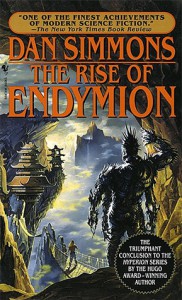The Rise of Endymion
 Once again, Simmons dazzles with sheer imagination. He builds wonders upon wonders in the Hyperion universe and never seems to fail at topping himself with something even grander (or stranger) as the tale progresses. Rise of the Endymion is a direct sequel to Endymion and picks up some years later on Old Earth as Aenea's apprenticeship under the architect (a cybrid construct of Frank Lloyd Wright) is wrapping up and the next phase of her journey is set to begin. Once again, we're 'cast through a pilgrimage of different worlds from the [b:Hyperion|77566|Hyperion (Hyperion Cantos, #1)|Dan Simmons|http://d.gr-assets.com/books/1332885131s/77566.jpg|1383900] storyline, this time more closely following Raul Endymion. His portion of the narrative expands with the progression of the story and we learn more about how he's able to include in his end-of-life narrative the stories of other individuals contemporaneous to his own experiences, but light years away.
Once again, Simmons dazzles with sheer imagination. He builds wonders upon wonders in the Hyperion universe and never seems to fail at topping himself with something even grander (or stranger) as the tale progresses. Rise of the Endymion is a direct sequel to Endymion and picks up some years later on Old Earth as Aenea's apprenticeship under the architect (a cybrid construct of Frank Lloyd Wright) is wrapping up and the next phase of her journey is set to begin. Once again, we're 'cast through a pilgrimage of different worlds from the [b:Hyperion|77566|Hyperion (Hyperion Cantos, #1)|Dan Simmons|http://d.gr-assets.com/books/1332885131s/77566.jpg|1383900] storyline, this time more closely following Raul Endymion. His portion of the narrative expands with the progression of the story and we learn more about how he's able to include in his end-of-life narrative the stories of other individuals contemporaneous to his own experiences, but light years away. The religious themes of the storyline continue to grow until they subsume the story itself. A genius introspective blend of Western Judeo-Christian mythology is alluded to in the story's central arc and there is Eastern mysticism and Central Asian world views suffusing the narrative as well. All of this is tactfully done. The experience is religious in nature, a progression toward Enlightenment cached in a story that is substantially scientific about the evolution of the human race with an expanded nestling in a wider universe that is home to other, bizzare forms of life. It's an intricate tale that weaves its way forward and backward in time and Simmons's notes for the series must have been absolutely bewildering. As many other reviewers have suggested, it does feel like there's some retconning going on near the end and Simmons makes it a point to flatly overturn previous versions of the narrative in favor of new ones by having Aenea explain the limitations of her Uncle Martin's accounting of events as he understood them in the original series set nearly 300 years previous. Is it a cheap trick? Usually, but not this time. I think I wrapped with the novel so in awe of this universe and so in love with it that I was willing to overlook the re-arranging of the house.
This second arc in the Hyperion Cantos is just absolutely epic and parts of its resolution are confusing as all hell. In some ways it reminds me a lot of LOST. There are just a ton of mysteries that you want resolution to: Who are the Lions, Tigers and Bears? Did they really take Old Earth, and if so why? What the hell is the Ultimate Intelligence in the future? Whose side is the Shrike on? Is Aenea a virus or a messiah? Some of these questions are answered quite satisfyingly. Others are left open. It certainly feels like Simmons left himself room to expand this universe and I'd love to see him delve back into it. Last I heard, he had returned an advance for a series of short stories set in the Hyperion universe, saying that he didn't feel any creative impulse to jump back into it. A real shame.
The endings of epic stories like these are always really difficult to pull off and I give Simmons a lot of credit for creating a satisfying resolution that is filled with real emotion. I think I enjoyed this cast of characters more than the original Shrike Pilgrims from the first duology. They seem...more real. More likable. I have to say I wasn't always the biggest fan of Raul, but he's the perfect everyman to stand in for us. Meanwhile, the cast of supporting characters are extraordinarily well done. I think several of them deserve tales in an anthology like the one planned by Simmons in their own right from the Dalai Llama to A. Bettik and the Thunderbolt Sow. I'm also pretty sure Father Captain Federico de Soya is one of my favorite characters in the series.
Well worth reading again too to see what I missed the first time through. This is probably one of the absolute best, mind-bending science fiction yarns out there. It doesn't get better than this.



